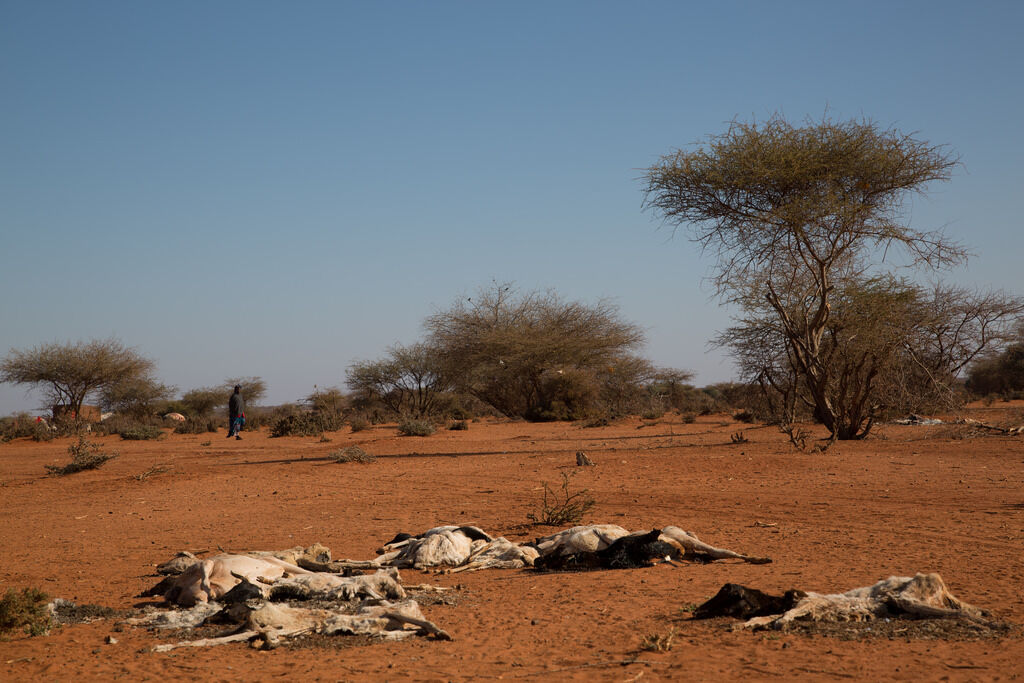- Austausch & Vernetzung
- Wissen & Lernen
- Advocacy
- Unsere Themen
Von Abdi Hersi
Somalia is in the grip of an intense drought, induced by two consecutive seasons of poor rainfall. In the worst affected areas, inadequate rainfall and lack of water has wiped out crops and killed livestock, while communities are being forced to sell their assets, and borrow food and money to survive.

According to the FAO-managed Food Security and Nutrition Analysis Unit (FSNAU) and the Famine Early Warning Systems Network (FEWSNET), the number of people in need of assistance has increased from five million in September 2016 to over 6.2 million now, more than half of the country’s population. This includes a drastic increase in the number of people in “crisis” and “emergency” from 1.1 million six months ago to a projected 3 million between February and June this year. The situation for children is especially grave. Some 363,000 acutely malnourished children are in need of critical nutrition support, including life-saving treatment for more than 71,000 severely malnourished children.
Acute drought in many parts of Somalia has reduced the availability of clean water sources, and the food crisis has given way to malnutrition. Drought conditions have increased the spread of epidemic-prone diseases such as acute watery diarrhoea, cholera and measles. In the first seven weeks of 2017, over 6'000 cases and 65 deaths by acute watery diarrhoea/cholera have been reported, and a total of 2'578 cases of suspected measles were reported at the end of 2016.

Swisso Kalmo is delivering medicines and medical supplies to communities in Lower Shabelle and Merka affected by the drought. We are reporting from a number of sentinel sites that are providing enhanced surveillance for epidemic-prone diseases such as cholera and measles. Cholera treatment centres have been established in the hospital to manage cases of severe acute watery diarrhoea/cholera.
The levels of suffering in the country, triggered by protracted conflict, seasonal shocks and disease outbreaks, are typically hard to bear, but the impact of this drought represents a threat of a different scale and magnitude. The situation we are starting to see today in many rural areas today is starting to look worryingly like the run-up to famine in 2010-2011. Most striking is the pace, scale and geography of deterioration, and the potential for the situation to become much much worse. Local food prices are rising; food availability is becoming patchy; animal deaths are increasing; and malnutrition rates are rising, especially among children. Together, these are all signs that we are entering a phase that can lead to catastrophe.

The combination of conflict, insecurity, mass displacement, recurrent droughts, flooding and extreme poverty, coupled with very low basic social service coverage, has seriously affected food security and livelihoods and greatly increased the population’s vulnerability to disease and malnutrition. Somalia is now facing a pre-famine situation where hundreds of thousands of Somali people are food and water shortages.
As a consequence of droughts, the two main rivers (Jubba and Shabelle) became dry causing lack of water for human and animals. In consequence of the drought and lack of water, communities experienced poor hygiene and sanitation especially in the IDP camps; as a consequence, there are AWD (acute watery diarrhoe) outbreaks in many districts and villages. In Lower Shabelle region and specifically Merka district, where Merka hospital is located and where SWISSO Kalmo has been implementing primary and secondary health care services, is one of the areas severely affected by the current droughts and AWD/Cholera.
Further aggravating the humanitarian situation in Lower Shabelle and Merka is the massive influx of displaced populations due to conflict, forced eviction and seasonal droughts in surrounding districts of Lower region. IDP and returnees’ settlements in Merka and surrounding villages have become very congested. This also exerts further pressure on the limited basic services and increases the transmission rates of communicable diseases to populations already facing high mortality and morbidity rates. Merka hospital is the only referral centre in Lower Shabelle which has been overwhelmed by people with different diseases mainly severely malnourished children and many AWD cases.
Water and pasture availability continue to be diminish as the drought toll takes effect, leading to deaths of livestock and migration of the affected people. This has affected the livelihoods of most of the pastoralists and agro-pastoralists in the areas affected. As a result of the drought main revivers become dry and there is lack of water for human and animals.
Currently Chiolera disease spread very rapidly affecting many people and killing many others. The most affected regions are Bay and Bakool. The number of Cholera cases and deaths in Bay and Bakool has been increase day by day. The spread of Cholera is agravated by lack of water and sanitation capouled by high malnutrition. In Somalia, there are shortages of medical supplies to contain the spread of Cholera.

The number of IDP community has been increasing from one region to another looking for water and food. Below is the data from UNHCR showing the movement burden of the community.

Swisso Kalmo is scaling up its response in Somalia to provide critical health services for people in Lower Shabelle Region through its hospital services for those currently affected by severe drought conditions and a worsening food crisis. However, the Organization urgently requires more financial support to scale up the response to pre-famine response. The health situation in Somalia continues to deteriorate, and there is a high risk that the country will face its third famine in 25 years. More than 6.2 million people – half of the total population – are in urgent need of humanitarian and health aid, including almost 3 million facing a food security crisis. Nearly 5.5 million people are at risk of contracting waterborne diseases, more than half of whom are women and children under 5 years of age.